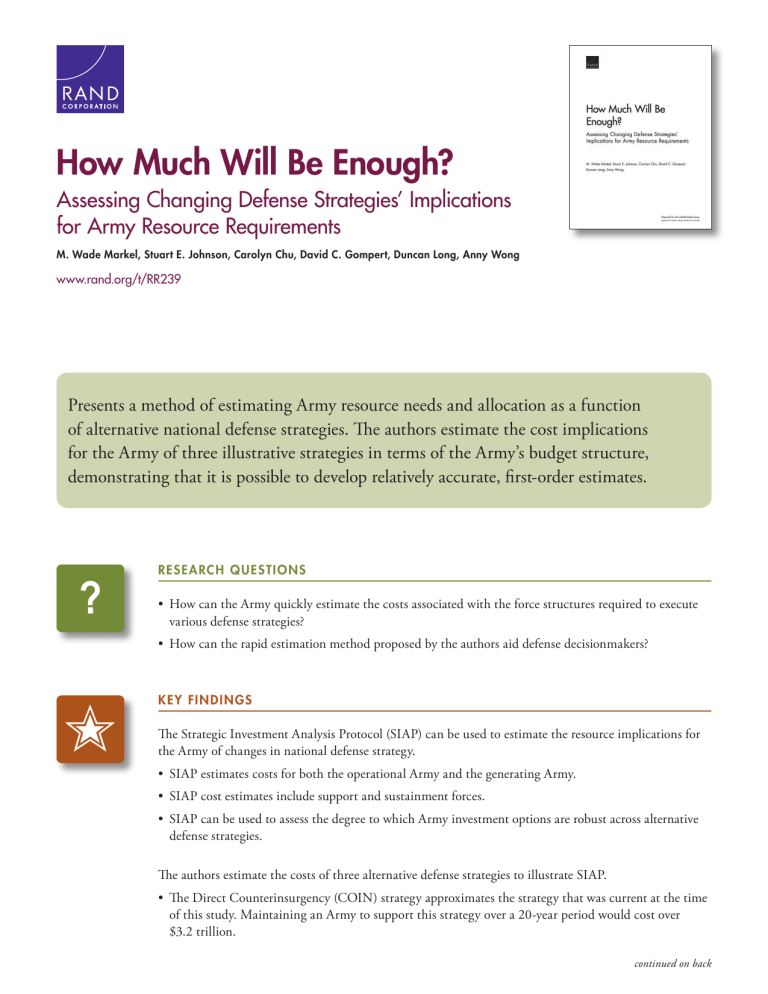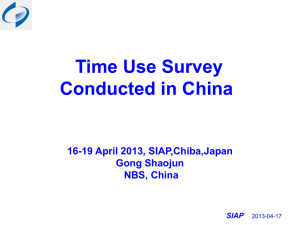How Much Will Be Enough? Assessing Changing Defense Strategies’ Implications

C O R P O R A T I O N
How Much Will Be Enough?
Assessing Changing Defense Strategies’ Implications for Army Resource Requirements
M. Wade Markel, Stuart E. Johnson, Carolyn Chu, David C. Gompert, Duncan Long, Anny Wong www.rand.org/t/RR239
Presents a method of estimating Army resource needs and allocation as a function of alternative national defense strategies. The authors estimate the cost implications for the Army of three illustrative strategies in terms of the Army’s budget structure, demonstrating that it is possible to develop relatively accurate, first-order estimates.
?
✭
RESEARCH QuEStionS
• How can the Army quickly estimate the costs associated with the force structures required to execute various defense strategies?
• How can the rapid estimation method proposed by the authors aid defense decisionmakers?
KEy FinDinGS
The Strategic Investment Analysis Protocol (SIAP) can be used to estimate the resource implications for the Army of changes in national defense strategy.
• SIAP estimates costs for both the operational Army and the generating Army.
• SIAP cost estimates include support and sustainment forces.
• SIAP can be used to assess the degree to which Army investment options are robust across alternative defense strategies.
The authors estimate the costs of three alternative defense strategies to illustrate SIAP.
• The Direct Counterinsurgency (COIN) strategy approximates the strategy that was current at the time of this study. Maintaining an Army to support this strategy over a 20-year period would cost over
$3.2 trillion.
continued on back
To Do
• The Build Local Defend Global strategy assumes that the primary threats to the United States arise from instability and that the United States can mitigate these threats by developing partners’ capabilities for governance. Maintaining an Army to support this strategy would cost approximately
$2.2 trillion over the same period.
• The Rising Peer strategy assumes that only a major peer or near-peer competitor, such as China, can threaten the security of the United States. The Army supporting this strategy would also cost about
$2.2 trillion.
SIAP provides Defense Department and Army leaders with a rapid means to estimate the costs of alternative strategies before one is selected.
• SIAP can quickly provide relatively accurate, first-order estimates of the resource implications for the
Army of alternative defense strategies.
• Its use can give senior leaders more precise guidance with which to initiate the force management requirements process.
• Because SIAP trades precision and accuracy for speed, it cannot substitute for existing planning and budgeting processes in providing a detailed and specific analysis of what is needed to implement a particular strategy.
RECoMMEnDAtionS
• The Army should use relatively accurate, first-order estimates of resource implications to inform the development and selection of defense strategies and the Army investment options that support those strategies.
• The Army should adopt SIAP as a cost estimation method.
ARROYO CENTER
RAND Arroyo Center is the Army’s federally funded research and development center for studies and analyses. Its mission is to help Army leaders make decisions that are informed by objective, high-quality analysis. For more information visit Arroyo’s website at www.rand.org/ard .

